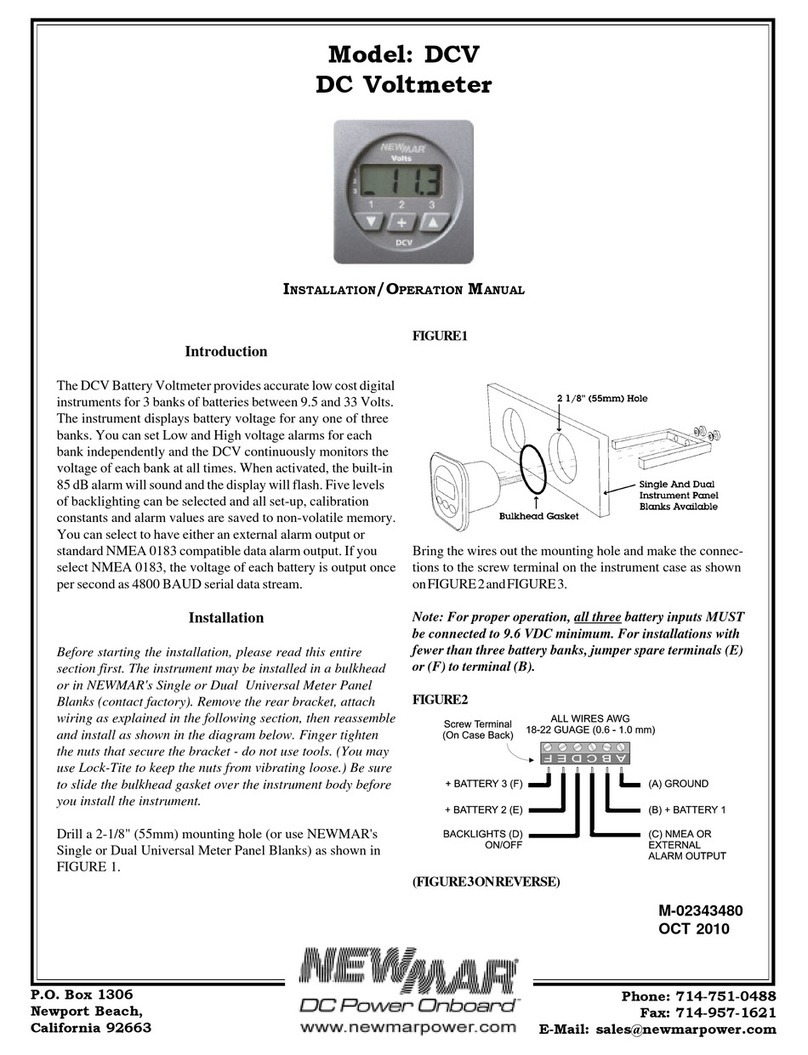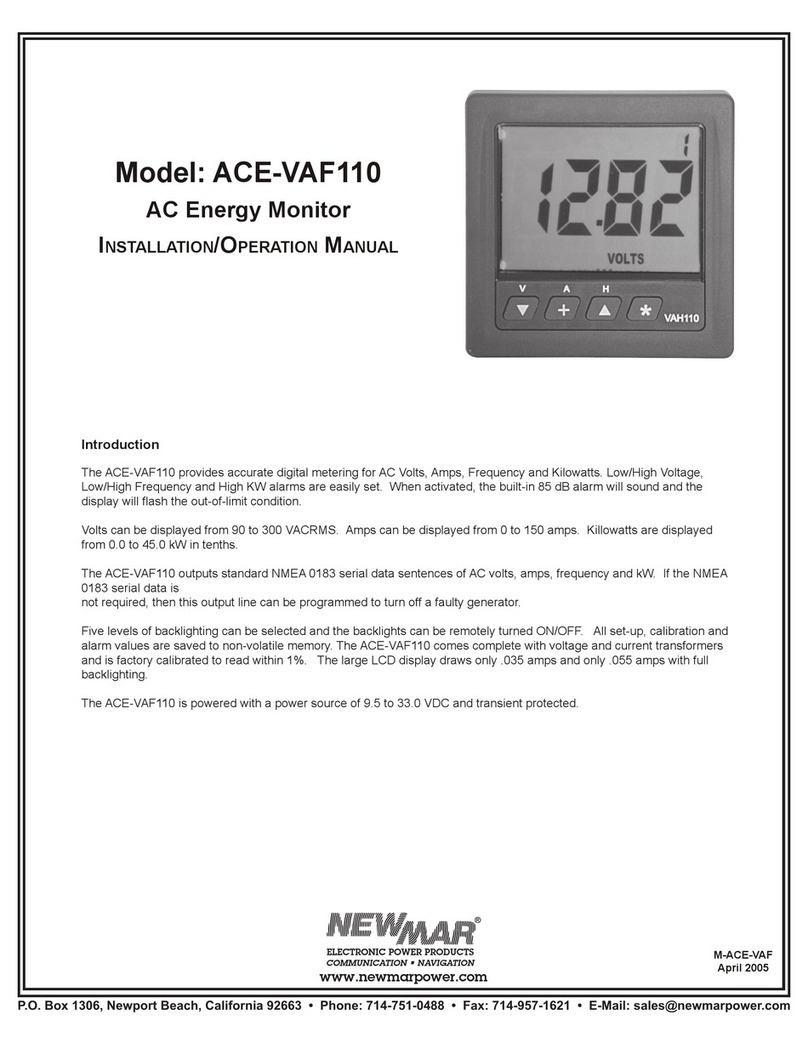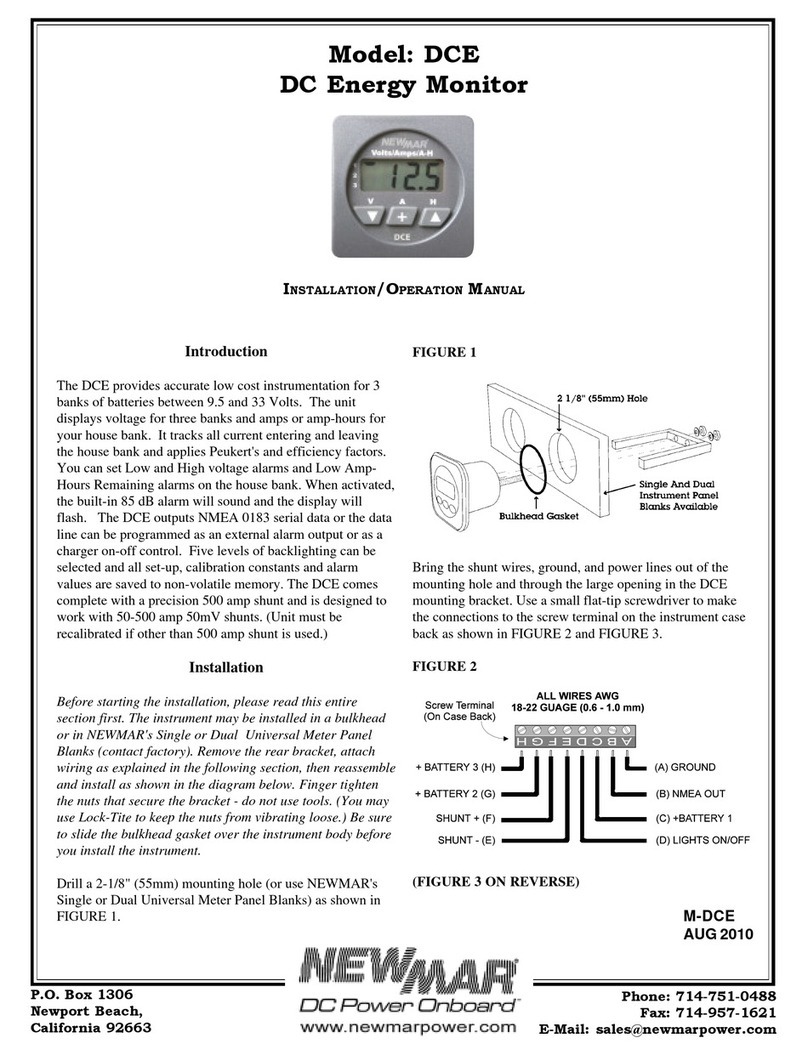
P.O. Box 1306
Newport Beach
California 92663
Phone: 714-751-0488
Fax: 714-957-1621
4
Option C: Rack Mounting
The unit can be rack mounted with Newmar optional 19” or 23” rack mounting kit, 2 RU (3.5 inches) tall,
model RM-SPM, P/N: 020-5091-0.
3.2 Wiring
Connections for both operating power and sensor inputs are made to the terminal block on the front panel.
The terminal block accommodates 16-22 gauge wire, and a small insulated screw driver is provided to ease
your connection process. Do not over tighten screws. Be sure to strip at least ¼” of the insulation off the wires
and fully insert them before tightening screws. It is recommended you tin the ends of stranded wire before
inserting in the terminal block.
WARNING: All un-grounded voltage inputs to the SPM must be fused with a 1 amp in-line fuses, except
for the A1, A2, and A3 switch inputs (floating contact), and the Is1 and Is2 shunt input (terminals 5 & 6).
AllreturnsandGROUNDSontheSPMarecommonwiththe–VDCinputterminal.
CAUTION: Do not make connections to the SPM with the power on, or with any live AC or DC sources!
Refer to FIGURE 1 and 2 for details on the following steps. Each terminal block position has a reference number
9 abbreviated ID, and full description (see TABLE 1).
CAUTION: Chassis Ground Stud: Connect to earth ground first! Stud size: #6-32
CAUTION: If you intend to power -48 VDC AND monitor -48 VDC, input power
must
come from an
isolated DC converter. If you need one, we will provide it free of charge. Contact Newmar: 800-854-3906
or E-mail: techservice@newmarpower.com and request model: 48-12-1i
3.2.1 DC Operating Power Input 9-60 VDC
Connectusing16-22AWGwire.ConnectyourmainDCpowersourcetothe–Vand+Vterminalsbeing
carefultoobserveproperpolarity.A1ampfastblowfuseonthe+Vinputisrecommendedforprotection.The
SPM draws approximately 200 m/A.
3.2.2 DC Voltage Monitor Ports
There are three ports total that monitor DC voltage. Two are rated for 0-40 VDC input, (terminals 15-16 and
17-18) and a third, (terminals 7-8) with inverse ground reference rated for 30-60 VDC input, intended primarily
for neg. 48 volt telecom system use. Note all DC sense voltage ties to the SPM must share a common ground
with the DC power source. CAUTION: If you intend to power -48 VDC AND monitor -48 VDC, input power must
come from an isolated DC converter. If you need one, we will provide it free of charge. Contact Newmar 800-
854-3906 or E-mail: techservice@newmarpower.com and request model: 48-12-1i
3.2.3 DC Current
Terminals 5 & 6 (Is1 and Is2) A 0-100mV DC shunt input and shunt are provided for measuring DC current
(not provided) Shunt can measure load current, rectifier current, battery current (charge and discharge),
depending on where the shunt is installed in the power distribution system. Use twisted pair wires for best
results and steady noise free readings. Install shunt in positive or negative lead. Polarity of the shunt output
can be swapped to achieve desired positive or negative current flow indication.
3.2.4 Dry Contact Switch Sensors
Terminals 9-10, 11-12, 13-14. Connect up to three devices with switched alarm contacts (N/C or N/O) between
A1 and A1 RTN. Assign user-friendly names on Display Tab on monitor that describe the specific functions of
each circuit. Some examples include: Magnetic Door Switch, Rectifier Alarms, Smoke Alarms, Battery Temp
Alarms, loss of voltage, contact relay closure, etc. Multiple switches can be installed in series, or paralleled in
a string to a single input to the SPM.






























